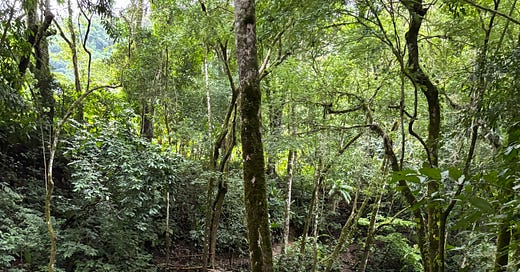A bird came out of my mouth and I’m still translating what that means. I’ve learnt by now that any journey to meet with an indigenous elder, to visit a culture and stay in a territory rich with wisdom takes me a long time to translate what took place.
We didn’t take any psychedelic medicine but the whole experience was psychedelic. Isn’t life inherently? But so much of our modern world, and socialized interactions, cut us off from that.
So it’s something about entering into an indigenous held territory that you can feel it so much more - time and space do not operate by the same rules. The psychic space doesn’t seem to be filled with same amount of neurosis, noise and clutter.
What I always observe is that on the surface these cultures live very simply. They’re not filled with the same amount of gadgets, buildings, books filled with intellectual discourse. Yet, in our modern world we are clearly starved from embodied wisdom and intelligence connected to our ‘more than human’ kin.
In these territories, time and time again, I peak through a window into a portal of complex knowledge systems stored throughout time. Information held within rituals, ceremonies and between individual knowledge keepers, their community, and the world around them.
You need very little, when you are that rich.
The important part is that this window into another world, connects me back to my own ancestral memory bank. I remember that 98+% of human history is primarily earth-based, semi-nomadic and animate - I.e connected to the world we live in. Intimately aware of the weather patterns, seasons, bird migrations, and animal tracks to not only survive but to thrive. Therefore, this ancestral memory is still deeply imprinted in my psyche.
Back to the bird coming out of my mouth - this was a dream and a sign to connect more deeply to the birds again.
What do they have to teach me?
What is it that I am here to learn?
Why did it come out of me?
A reminder that the confines of who I think I am, are blurred with the environment I am in, by shared microbes and bacteria, breath and water.
The birds are known as the messengers and bridges between earth and spirit, and so I am also reminded that I am that too.
What is my message at this time?
I wrote in a previous article ‘The Times Are Urgent: Let’s Dream’ - this extends to: let’s live, let’s feel, let’s remember, let’s gather, let’s connect and let’s tell the old stories again, to build the new ones.
Our world is made up of stories, stories that have a lot of influence on how we see ourselves and what actions we take personally and collectively.
When I began obsessively researching deep time history, and learning with cultures who hold the most intact through-line to deep time (indigenous peoples), again and again, I’d find that the information I was processing cognitively, was shifting something within me more profoundly - my sense of self, my sense of the world, my sense of what is possible, even my physiology.
This is living research, where all my senses, emotions and embodied connections matter. Where I accept that I can never be separate or truly objective, from what I’m learning about, and I wouldn’t want to be. I am always the filter of what I am learning through. Information enters through my prism of body, experience, emotion and memory, so I better understand who I am - to also track how I transform and change through what I learn about.
Within this methodology dreams become keys within our consciousness. They are signposts, reminders and pathways to live in greater connection again, to ourself, our community, and our animal kin.
From the Western Scientific perspective there isn't a consensus on what dreaming is, or, why we dream.
The theories explored are from Freudian ‘fulfillment of unconscious wishes’, to emotional processing, to consolidating memories, to survival simulation, to just an accidental by-product of sleep, or a virtual reality of our own making, and the gateway to understanding consciousness itself.
Most neuroscientists and psychologists today agree that dreams and our waking life overlap, and that the brain’s mental processes are shared. Thus to understand dreaming we need to understand how we generate thoughts and images when we’re awake, and how consciousness works. We’re still a long way from understanding that within science.
“Dreaming is a phenomenon that we cannot share. We can’t invite anybody into our dream world and say, “Yeah, I have these interesting dreams — please come and take a look.” So we can’t share dreams in any kind of empirical way. They are non-transmissible in some very fundamental manner. And that’s the problem with consciousness as well. Consciousness is subjective. And that’s the challenge for science. How can we do science on a phenomenon that is fundamentally experienced only by one person?”
— Antti Revonsuo, professor of cognitive neuroscience
While modern science grapples with the question of consciousness within a highly individualistic society, indigenous cultures tend to have a much more unified and holistic sense of reality because life is centered around community and a relationship to the ‘more than human world.’
Dreams are shared within the community because they are understood to have significance for the shared reality community members live within.
If dreams mirror our waking lives, and potentially in reverse, our dreams can seep into our waking life, we may be limited by the perspectives of our familial and societal conditioning for how we dream. This is why we’re looking to dreaming in new and ancient ways to expand the possibilities of our waking life.
Join us on this journey within our up-coming short course: Dreams ~ a living research methodology
Doors close at 11pm PST June 25th
We are exploring…
Week 1 - Introduction to the Living Research methodology & introduction dream - we review what the science says about dreams.
Week 2 - we will look to cross-cultural examples from the Guatemala Maya, Parintintin and Guarani of Brazil, Ese Eia peoples of Peru and Bolivia, and more, and look to how we may integrate these perspectives into our own lives.
Week 3 - we will look to the anthropologists who have incorporated their own dreams in their research & opened to ‘extraordinary’ experiences. To then open to, and ground, our own ‘extraordinary’ experiences.
Week 4 - explores the ethical implications, and equally the importance of incorporating dreaming practices into a research methodology. What are we personally here to research and learn about, and how can dreaming practices support this?
Week 5 - we dive deeper into the symbols, interpretations & potential value of dreams in our life.
Week 6 - we will integrate more dreaming practices and come full circle on this journey.
Once we’ve completed our modules, we will meet for a live Q&A, to explore in real time what we have experienced and can learn from one another.
Throughout, you have access to a community integration hub to share your experiences.
I share more from my Living Research and Storytelling of this journey to the Cabecar and Bri Bri territories in Costa Rica here — i’ll be sharing more about this dream there next.







